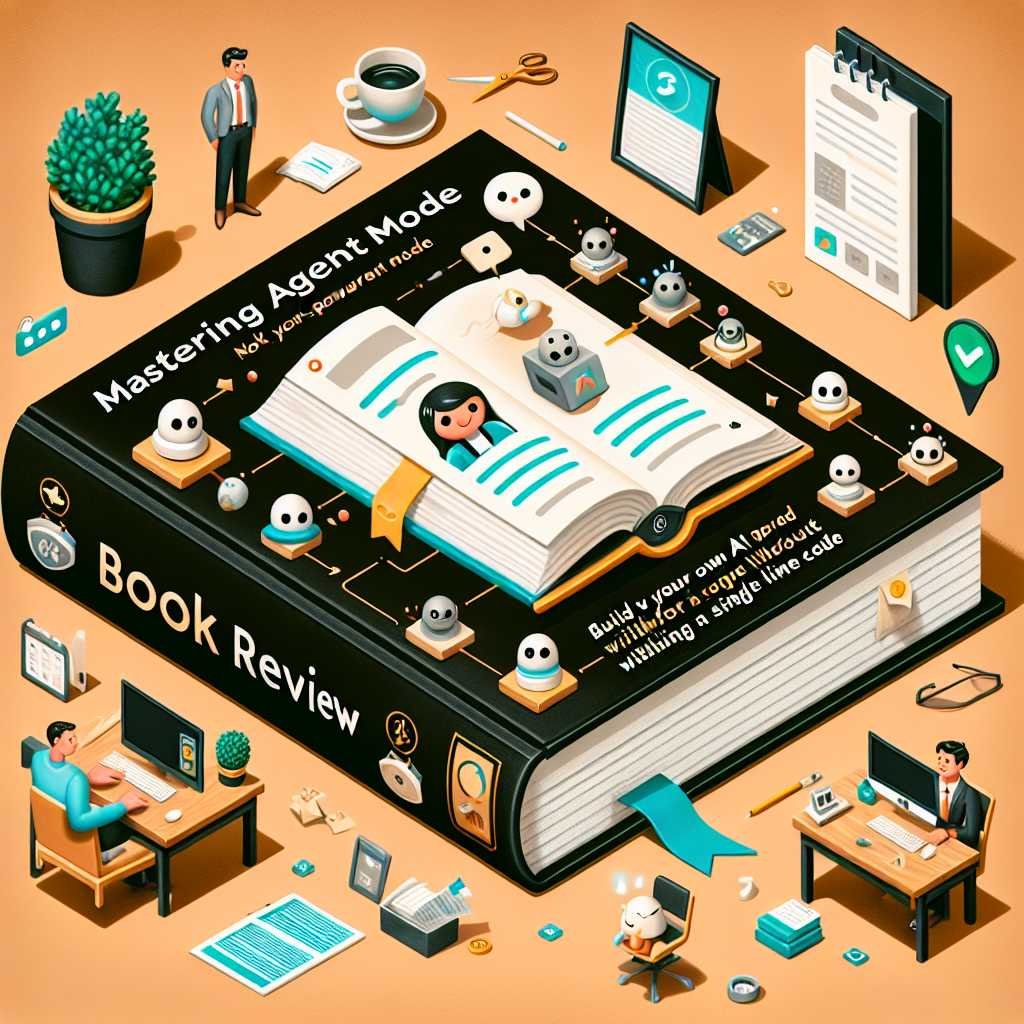Book Review: Mastering ChatGPT Agent Mode — Build an AI-Powered Workforce Without Writing a Line of Code
Imagine hiring 16 tireless assistants this month—no resumes, no payroll, no code. They never sleep, they scale as your business grows, and they work inside tools you already use. That’s the bold promise behind Mastering ChatGPT Agent Mode, a practical playbook that shows non-technical users how to deploy a team of AI “agents” to run marketing, customer service, design, analytics, and operations.
If you’ve been curious about turning ChatGPT into an actual working system—not just a clever chat window—this book meets you where you are. It’s upbeat, actionable, and focused on results. And yes, it’s written for people who don’t code.
In this review, I’ll break down what the book covers, who it’s best for, and where it shines (and falls short). I’ll also walk through the standout case study—a handmade t‑shirt business—and share a fast-start plan you can copy in under an hour.
Let’s dig in.
What This Book Is Really About (And Why It Matters)
Mastering ChatGPT Agent Mode isn’t another “AI is the future” pep talk. It’s a no-code field manual for setting up your own AI-powered workforce using ChatGPT and off-the-shelf tools. The author positions Agent Mode as a framework: define roles, design workflows, and give each agent guardrails and goals. If you can describe what you want in clear language, you can automate the busywork that eats your day.
Here’s why that matters: most small teams don’t have time to learn Python or build custom apps. They need outcomes—faster customer replies, better product descriptions, consistent content, smarter ad targeting. This book shows you how to get there without becoming a developer.
What Is “ChatGPT Agent Mode,” Exactly?
“Agent Mode” isn’t an official brand name from OpenAI—it’s the book’s term for structuring ChatGPT as a set of role-based agents, each with a specific job, workflow, and toolkit. Think of it like hiring specialty freelancers who follow playbooks.
- Each agent has a purpose (e.g., “Customer Support Triage”).
- You feed it a prompt template, context, and examples.
- You connect it to tools (like Google Sheets or Canva) through simple workflows or integrations.
- Then you run the system: the agent takes inputs, produces outputs, and hands off to the next agent when needed.
If you’re curious about the underlying tech, check out: – OpenAI’s Assistants overview: OpenAI Assistants – Prompt engineering best practices: OpenAI Prompt Engineering – Custom GPTs overview: What are GPTs?
The book keeps things no-code and practical, often recommending tool bridges like Zapier for automation or manual CSV imports when that’s faster.
Who This Book Is For (And Not For)
You’ll get the most value if you’re: – A solo entrepreneur or small business owner – An Etsy or Amazon Handmade seller – A marketing manager or operations lead – A project manager tasked with “make AI work for us—now”
You may want something else if you’re: – A developer seeking deep architectural patterns or SDK code – An enterprise leader needing governance frameworks and MLOps – Looking for platform-specific coverage beyond ChatGPT and common SaaS tools
What You’ll Learn Inside
The book promises a full AI bootcamp for business owners, and it largely delivers. Highlights include:
- How to activate and use ChatGPT’s agent-like capabilities from scratch
- How to build 16 role-based AI agents for marketing, support, SEO, design, analytics, and ops
- How to integrate tools like Canva, Google Sheets, Adobe Creative Cloud, Amazon Seller Central, Etsy, and Google Ads
- 100 step-by-step actions you can follow with no coding experience
- A complete automation system for a handmade t‑shirt shop (adaptable to any commerce niche)
- Prompt templates and reusable workflows
The emphasis is on practicality—short steps, checklists, real examples, and “do this, then that” instructions.
Inside the Book: Structure and Standout Chapters
The book reads like a guided workshop. It’s broken into five parts:
1) Foundations: Agent Mode basics, how to think in roles and workflows, and how to scope your first system. 2) The Agents: 16 roles with prompts, inputs, outputs, and guardrails. 3) Tooling: Connecting ChatGPT with common tools through no-code methods. 4) The Case Study: A t‑shirt business automated end-to-end. 5) Scaling: Managing quality, cost, logging, and iteration.
Standout sections: – “Role Cards” for each agent with inputs, outputs, and failure modes. It’s simple and usable. – “Do-first” prompts that get you to value quickly instead of theory. – Troubleshooting tips like “What to do if your agent hallucinates” or “How to tighten a prompt when outputs drift.”
The 16 AI Agents You’ll Build (High-Level Roster)
The book organizes agents by function. Here’s a quick tour with sample use cases.
Marketing and Growth Agents
- Content Strategist: Plans your blog and social calendar. Input: niche + goals. Output: 90-day content plan with SEO clusters.
- SEO Optimizer: Writes titles, meta descriptions, and schema suggestions. Input: URLs/keywords. Output: SEO-ready copy.
- Email Copywriter: Drafts welcome series and promotions. Input: persona + offer. Output: plain-text and HTML-ready copy.
- Ads Strategist: Proposes campaigns and assets. Input: product + budget. Output: creatives, headlines, and targeting ideas for Google Ads or social platforms.
Creative and Product Agents
- Product Describer: Turns features into benefits and bullet points. Input: product details. Output: listings tailored to Amazon Handmade/Etsy style guides.
- Design Assistant: Creates design briefs and prompts for Canva or Adobe Illustrator. Input: brand mood board. Output: layout suggestions and prompt language for templates.
- Image Variation Agent: Suggests batch variations for seasonal drops. Input: base design. Output: prompt/briefs for quick templating.
Sales and Support Agents
- Customer Support Triage: Classifies inbound messages and drafts replies. Input: customer email. Output: response templates and tags.
- Review Reply Agent: Writes empathetic replies to reviews. Input: review text. Output: public response + private follow-up.
- Return/Refund Explainer: Generates clear, policy-compliant messages. Input: order details. Output: tailored instructions and labels.
Operations and Analytics Agents
- Inventory Tracker Assistant: Summarizes stock levels from a sheet and flags issues. Input: spreadsheet. Output: reorder alerts.
- Pricing Analyst: Compares competitor pricing and suggests thresholds. Input: CSV or notes. Output: pricing tiers and guardrails.
- KPI Reporter: Turns raw metrics into weekly summaries. Input: Google Sheets or exports. Output: insights, trends, and recommended actions.
- SOP Builder: Converts your processes into standard operating procedures. Input: rough steps. Output: formatted SOPs with checklists.
Project and Workflow Agents
- Orchestrator: Manages handoffs between agents. Input: project briefs. Output: task queue and status updates.
- Quality Control: Checks outputs for tone, accuracy, and brand fit. Input: drafts/creatives. Output: edits, risk flags, and approval scores.
Each agent is paired with prompt templates and inputs/outputs, so you can plug them into your current tool stack.
Tool Integrations: How It All Connects Without Code
You won’t write code, but you will connect your agents to data and tools. The book’s approach is pragmatic:
- Google Sheets as your hub: store SKUs, keywords, inventory, and campaign metrics. It’s flexible and easy to audit. Google Sheets
- Canva for templated creatives: use design prompts and brand kits for fast iteration. Canva
- Adobe for pro-grade assets: when you need vector control or advanced compositing. Adobe Creative Cloud
- Amazon and Etsy workflows: follow marketplace guidelines and listing structures. Amazon Seller Central, Etsy Seller Handbook
- Ads platforms: export/import spreadsheets for keywords, creatives, and budgets. Google Ads
- Automation bridges: use tools like Zapier to move files, sync sheets, and trigger tasks
- Privacy and compliance: handle customer data responsibly. If you sell in the EU, read up on GDPR
Let me explain why this matters: integrations are where most DIY AI projects stall. This book avoids that by showing low-friction ways to move data between systems—CSV exports/imports, shared drives, and simple zaps—rather than pushing complex APIs.
The Case Study: Automating a Handmade T‑Shirt Business
This is the heart of the book. You follow a t‑shirt shop from idea to delivery while the AI agents do the heavy lifting. Here’s the condensed flow:
1) Niche discovery: The Content Strategist surfaces themes (e.g., hiking dads, plant moms, retro gamers). 2) Design briefs: The Design Assistant generates prompts and layout ideas for Canva. 3) Mockups: You batch-apply designs to t‑shirt templates and create storefront images. 4) Listings: The Product Describer drafts titles, bullets, and SEO-friendly tags for Amazon Handmade and Etsy formats. 5) Ads launch: The Ads Strategist builds test campaigns with keywords, headlines, and image variations. 6) Support setup: The Support Triage agent prepares macro replies and message tags for common questions. 7) Inventory: The Inventory Assistant monitors your sheet, flags low stock, and auto-generates reorder drafts. 8) Reporting: The KPI Reporter compiles weekly dashboards, notes trends, and recommends tweaks.
The system is modular. Selling mugs instead of shirts? Swap the product details and keep the workflow. That adaptability is a big win.
Strengths: Where the Book Delivers
- Accessible and non-technical: You can implement most steps in a weekend.
- Role-based design: Agents are scoped with clear inputs and outputs, which reduces chaos.
- Templates that work: The prompts are tight, repeatable, and easy to customize.
- Real business focus: Examples are grounded in Amazon/Etsy operations, not abstract demos.
- Risk-aware: There’s guidance on hallucinations, tone control, and quality checks.
- Iteration mindset: You’re encouraged to start small, measure, and refine.
In short, it’s pragmatic. It helps you ship, not just learn.
Gaps and Caveats: What’s Missing (or Needs Caution)
No book is perfect. A few things to watch:
- Orchestration complexity: Multi-agent handoffs can get messy. The book’s Orchestrator agent helps, but you’ll still need discipline—naming conventions, logging, and versioning.
- Tool limits: Deep integrations (e.g., live ad API tuning) aren’t covered. You’ll rely on exports/imports or no-code bridges.
- Cost management: More actions can mean more spend. Track tokens and tool fees. Check OpenAI pricing and set budgets for ads and design assets.
- Data privacy: Be cautious with PII. The book mentions safety, but you’ll want clear policies, especially if you operate under GDPR. See GDPR overview.
- Platform changes: AI platforms evolve. Bookmark official docs (like the OpenAI Assistants) and expect to adjust.
None of these are deal-breakers, but you should go in with eyes open.
A 60-Minute Quick Start (Based on the Book)
Want a win before lunch? Try this:
1) Define one outcome: “Reply to customer emails within 2 hours with consistent tone.” 2) Create a role card: Customer Support Triage. Inputs: email text + policy doc. Output: draft reply + tags. 3) Draft your base prompt: Include tone rules, brand voice, escalation triggers, and examples. 4) Gather context: paste your refund/return policy and top 10 support questions. 5) Set up a “reply builder” doc: Sections for greeting, main answer, next steps, closing. 6) Run 5 real emails: Generate replies, edit lightly, send. Log response time. 7) Add a Quality Control checkpoint: A short prompt that double-checks tone and accuracy. 8) Create macros/shortcuts: Save your top replies as templates. 9) Measure: Track average time to reply and customer satisfaction for a week. 10) Iterate: Tweak the prompt when replies drift, and add new examples as edge cases appear.
You just built your first agent. Now rinse and repeat for listings, ads, or analytics.
Common Pitfalls and How to Avoid Them
- Vague prompts: If inputs are fuzzy, outputs will be too. Write clear role cards with examples.
- Too many agents at once: Start with a single high-impact agent. Expand after you get one win.
- No handoff rules: Define when an agent passes work to the next. Use a simple checklist.
- Ignoring quality control: Add a QC agent that reviews outputs for tone, accuracy, and compliance.
- Not logging decisions: Keep a changelog. Note what you changed and why. It speeds up debugging.
- Over-automation: Keep a human in the loop for public-facing content and significant financial decisions.
How It Compares to Other AI Business Guides
Compared to generic AI overviews, this book is more hands-on and business-first. It focuses on “do this today” rather than theory. Versus technical AI books, it’s lighter on architecture and heavier on workflows. For small teams and non-technical operators, that’s a feature, not a bug.
If you want to go deeper on risk and governance, you might supplement with the NIST AI Risk Management Framework. For complex automations, explore Zapier tutorials. And for platform mechanics, stick close to the OpenAI docs.
Who Will Get the Most ROI
- Marketplace sellers (Amazon Handmade, Etsy) who need consistent listings, faster responses, and better creative.
- Service businesses that want a content engine and better lead handling.
- Marketing teams that need repeatable campaigns and reports.
- Ops leads who want clean SOPs and predictable handoffs.
If you’re already running a code-heavy stack or need real-time data pipelines, you’ll outgrow parts of the book, but the role-based approach still applies.
The Verdict: Should You Read It?
Yes—if you’re serious about putting AI to work in your business without hiring a developer. Mastering ChatGPT Agent Mode balances clarity, practicality, and momentum. It gives you a language for designing agents, a structure for connecting them, and enough templates to move from idea to implementation fast.
It’s not a silver bullet, and you’ll still need to manage quality, costs, and privacy. But if you want to stop dabbling and start operating with AI, this is a strong place to start.
FAQ: People Also Ask About ChatGPT Agents and No‑Code Automation
Q: What is ChatGPT Agent Mode?
A: It’s a role-based way to use ChatGPT as a set of specialized “agents” that run tasks like support, marketing, and analytics. Each agent has prompts, inputs, outputs, and guardrails. The concept aligns with role-based assistants described in OpenAI’s docs.
Q: Do I need to know how to code?
A: No. The book is designed for non-technical users. You’ll use prompts, spreadsheets, and simple integrations (often via Zapier).
Q: Which tools does it integrate with?
A: Examples include Google Sheets, Canva, Adobe Creative Cloud, Amazon Seller Central, Etsy, and Google Ads.
Q: Can this replace employees?
A: It’s better to think of agents as “assistants.” They handle repetitive work so humans can focus on creative, strategic, and relationship tasks. Keep a human in the loop for quality and decisions that affect customers and cash flow.
Q: How do I avoid AI hallucinations or off-brand messages?
A: Use tight prompts, clear tone rules, and a Quality Control agent. Include examples, policies, and a checklist. See OpenAI’s prompt best practices.
Q: Is my data safe with AI tools?
A: Treat customer data carefully. Avoid pasting sensitive information unless you’ve reviewed the platform’s privacy terms, and if you operate in the EU, understand GDPR. Minimize personally identifiable information (PII) wherever possible.
Q: How much will this cost?
A: Costs vary by usage and tools. Budget for AI usage, ads spend, and any paid SaaS. Review OpenAI pricing and set thresholds inside your workflows.
Q: Will this work for businesses outside of e‑commerce?
A: Yes. The case study focuses on a t‑shirt shop, but the agent model applies to coaching, agencies, local services, and more. Swap in your processes and tools.
Q: What’s the fastest way to start?
A: Build one high-impact agent—usually Support Triage or SEO Listings. Measure the time saved and quality improvement, then expand.
Q: How do agents talk to each other?
A: The book uses an Orchestrator approach: define handoffs, inputs/outputs, and triggers. You can keep it simple with shared docs/sheets or use automation bridges like Zapier.
Final Takeaway
Mastering ChatGPT Agent Mode gives non-technical teams a clear, repeatable way to build an AI-powered workforce. Start with one agent and one outcome. Add a quality check. Log your changes. Then scale. If you want a guide that’s equal parts practical and optimistic, this book earns a spot on your desk.
Want more deep-dive reviews and step-by-step AI playbooks? Subscribe for the next breakdown and a free agent role-card template you can use today.
Discover more at InnoVirtuoso.com
I would love some feedback on my writing so if you have any, please don’t hesitate to leave a comment around here or in any platforms that is convenient for you.
For more on tech and other topics, explore InnoVirtuoso.com anytime. Subscribe to my newsletter and join our growing community—we’ll create something magical together. I promise, it’ll never be boring!
Stay updated with the latest news—subscribe to our newsletter today!
Thank you all—wishing you an amazing day ahead!
Read more Literature Reviews at InnoVirtuoso
- Shadowbanned: The War on Truth and How to Escape It — Book Review, Insights, and the Digital Free Speech Survival Guide
- The Art and Science of Vibe Coding: How Kevin L Hauser’s Book Unlocks the Future of No-Code AI Software Creation
- Quantum Computing: Principles, Programming, and Possibilities – Why Anshuman Mishra’s Comprehensive Guide Is a Must-Read for Students and Researchers
- Book Review: How “Like” Became the Button That Changed the World – Insights from Martin Reeves & Bob Goodson
- Book Review: Age of Invisible Machines (2nd Edition) — How Robb Wilson & Josh Tyson’s Prophetic AI Playbook Prepares Leaders for 2027 and Beyond
- Almost Timeless: The 48 Foundation Principles of Generative AI – Why Mastering Principles Beats Chasing Hacks
- The AI Evolution: Why Every Business Leader Needs Jason Michael Perry’s Roadmap for the Future







